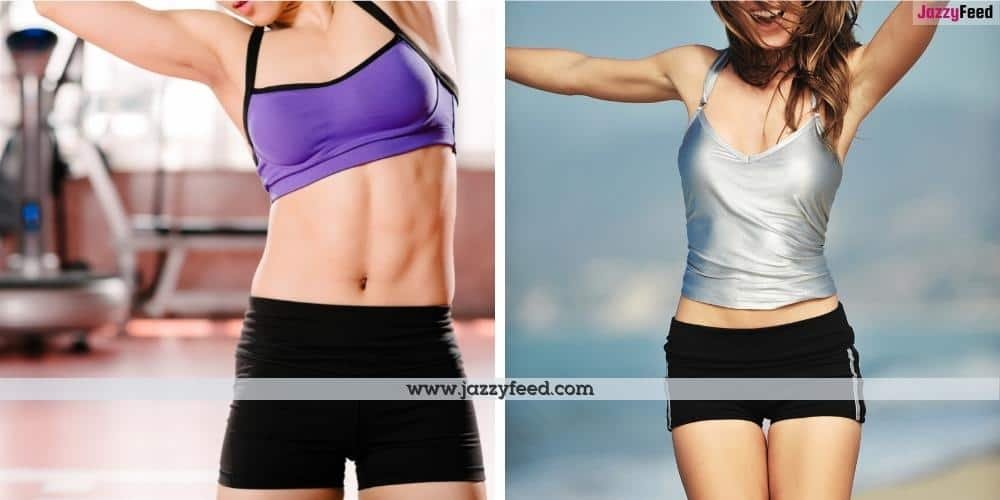For as long as I can remember, physical fitness has been a part of my life. I’ve witnessed significant changes in the fitness industry over the years. Clothing has been one of the most noticeable modifications. People used to dress in whatever they could find that was comfortable.

The clothing used by athletes has improved thanks to advances in technology, science, and knowledge. In the field of fitness, compression gear has made great gains. Compression sleeves, shorts, and other compression clothing have dominated the market. Continue reading if you’re still unsure what compression shorts are.
What are Compression Shorts?
Athletes typically wear compression shorts and tights. Similar to bicycle shorts, they are form-fitting clothes that cover the wearer’s waist from the mid or lower thigh. In Japan, they’re known as spats, while in South Korea, they’re known as safety shorts.
Many come with a cup pocket, which is a sewn-in pocket that holds a protective cup. Compression shorts, unlike jockstraps, may not retain cups in the appropriate place, snug to the body and not shifting. The compression shorts are worn by some male players instead of the customary jockstrap.
Compression shorts are also popular among female athletes, particularly those who compete in skirts or kilts. Athletes wear compression shorts under their skirts in these instances so that their underwear is not visible if they fall over and their skirts ride up. This is especially evident in field hockey and women’s lacrosse (both being limited contact sports in which players often wear skirts).
Compression shorts are also worn by women in tennis, whereas compression shorts with ball pockets have recently been introduced for added convenience.
What Are the Benefits of Compression for Runners?
Compression boosts blood flow to your muscles and distributes more nutrients to them, giving them more of what they need to operate at their best during rigorous activity. Compression, on the other hand, may provide additional running benefits.
When you run in compression shorts, you become more aerodynamic. Smooth, tight-fitting shorts create a streamlined shape that eliminates drag. “A minor aerodynamic drag decrease” can result in a performance boost, according to a landmark study published in the Medicine & Science in Sports and Exercise journal. This is especially useful in high-intensity activities like jogging.
Compression shorts’ elasticity may also give support for joint movements. The elasticity of compression gear, according to a clinical trial published in the Journal of Sports Science, can increase flexion and extension torque and “help the hamstrings in regulating the leg at the end of the swing phase in sprinting.” The compression shorts also lowered impact force, according to the researchers.
The benefits of compression shorts are highlighted in this study. Joints are supported during movements to improve performance, and impact force is decreased to prevent injury risk.
Finally, compression shorts aid in body temperature regulation. Nike Dri-FIT technology, for example, moves perspiration and moisture away from the skin and into the garment, where it evaporates. Improved thermoregulation can help athletes perform better. When your body’s temperature rises, it needs to work harder to cool down, which consumes energy that could be better spent on your sport.

What are the Types of Compression Shorts?
Compression shorts, which are designed to boost performance by applying pressure to your muscles, are a good option if you need a little more support throughout your workouts. The best compression shorts for women are produced with a high proportion of spandex and come in a length and style that you like.
If you want to wear compression shorts for medical reasons or if you have any unique health concerns, you should first consult your doctor. However, if you’re just looking for some more assistance throughout your workouts, there are a few things to consider.
Spandex (also known as elastane) is a highly elastic fabric that is ideal for compression garments. Spandex shorts are not only form-fitting but also tight enough to squeeze your leg muscles. Some athletes have reported increased endurance from this pressure, and many firms claim that it enhances blood circulation, however, that claim may be exaggerated. If you’re buying compression shorts for whatever reason, make sure the manufacturer specifies that they’re built for compression, so you know they’re not just cycling shorts.
In addition, compression shorts are available in a variety of inseam lengths, ranging from 3 to 10 inches. If you want to wear your compression shorts under other clothing, 3-inch shorts are a good choice because they are easier to hide. Longer pairs can help reduce chafing in the legs, which some individuals prefer.
Compression shorts with various design characteristics, such as outer pockets for holding a phone and inner pockets for cards, cash, and keys, are also available. Some shorts include a hidden drawstring for a snug fit, while others have a wide, comfy elastic waistband. If you don’t like becoming sweaty during your workouts, search for shorts with moisture-wicking capabilities. Shorts with a high percentage of cotton are more breathable, but they don’t handle perspiration as well.
Basic Compression Shorts
This three-pack of compression volleyball shorts allows you to work out many days without having to wash them. It’s also a terrific alternative for anyone who exercises out frequently and is on a budget. These shorts are constructed of 87 percent polyester and 13 percent spandex and have a 7-inch inseam, though you may choose the 3-inch alternative if you prefer a shorter short.
They’re available in black, blue, and charcoal, with a comfy elastic waistband on each pair. These performance shorts have a gusseted crotch and flat-lock seams to minimize chafing and are moisture-wicking.

Classic 7-Inch Compression Shorts With Pockets
This is the choice for you if you’re seeking mid-length compression shorts with a classic biker design. These shorts offer a wide mid-rise waistband and flat-lock seams to assist minimize chafing during any activity but notably walking and jogging.
They’re made of 80% nylon and 20% spandex and offer four-way stretch and quick-drying properties to keep you cool even on the warmest days. The two practical side pockets and the rear waistband pocket, which are excellent for holding phones, keys, hair bands, and other things, are another reason to love these shorts.

High Waist Biker Compression Shorts
With nearly 40,000 five-star reviews on Amazon, these compression bike shorts are a huge hit. They’re constructed of a buttery soft fabric that’s 75 percent nylon and 25 percent spandex, and there’s a drawstring inside the waistband to alter the fit. These shorts include a seamless crotch and a high-waisted style for excellent support, as well as side pockets for phones, keys, and important cards to keep you comfy. With over 40 color and pattern possibilities, including tie-dye, purple, and charcoal grey, they not only feel fantastic, but they also look terrific.

How Do Compression Shorts Work?
Compression shorts apply moderate pressure to the tissues beneath the skin. This pressure speeds up venous blood flow or the return of deoxygenated blood to the heart. The blood that travels from the heart to the muscles is oxygenated and nutrient-rich, giving your muscles exactly what they require during exercise. These shorts can help you have more endurance, strength, and recuperation time by boosting circulation and blood flow.
But what are the main mechanisms that make these advantages possible? Wearing compression shorts may help:
- Remove lactic acid buildup in the muscles by filtering it out.
- Increase the amount of adenosine triphosphate (ATP), the energy that muscles utilise to move.
- To minimise edoema, increase lymph flow to eliminate waste products.
- Reduce muscular oscillation, which causes muscle injury and microtrauma when it ripples through your body on impact.
- By reducing the symptoms of delayed onset muscular soreness, you can feel better (DOMS).
What are Compression Shorts Made of?
Compression shorts are constructed of a stretchy material that conforms to your body and creates compression (pressure) in your buttocks and thighs, similar to spandex shorts. Many studies have looked into the effects of compression shorts on athletic performance and injury prevention, and many have found that they are beneficial to athletes.
Do I Wear Anything Under Compression Shorts?
If you answered yes, you should stop. When your workouts become more intensive, you will sweat a lot, and the underwear will absorb all of the sweat and moisture from your skin. This will cause your compression shorts to become damp, reducing their breathability. Your compression shorts won’t be able to regulate your body temperature either. This will simply cause you to sweat more, causing you to become burnt out faster.
Furthermore, you will be uncomfortable around them. Because of the extra layer that will bunch under your compression shorts, this will happen. You can see how compression clothes operate in the video below.
How Long Should You Wear Compression Shorts?
Compression shorts are a useful strategy for decreasing the onset of muscular weariness. The shorts’ snug fit promotes blood flow and forces blood back to your heart. Your muscles will feel fresh as a result of the increased blood flow, whereas others will feel exhausted.
Have you ever gotten a deep-tissue massage after a hard workout? If you answered yes, you’re aware that applying pressure to a muscle area helps lessen inflammation and pain. Compression wear has the same euphoric impact as massage; wearing the shorts after your workout for a period of time (1-2 hours) will significantly minimize swelling and weariness.
What to Wear with Your Compression Shorts?
Compression shorts can be worn alone or with a looser layer over the top. Wearing compression shorts during and after your workout is a simple change that comes with a lot of benefits. Don’t let this opportunity pass you by.
Is it OK to Wear Compression Pants All Day?
You may find compression pants to be quite comfortable, and you will have no issue working out or watching Netflix in them all day. Alternatively, you may find them too tight and confining to wear for long periods of time.
You can wear compression pants for as long as you like (you can even sleep in them if you’re comfy!). Just be cautious if you have a history of certain medical conditions or if your doctor has advised you to wear them. “Due to the degree of the compression, there are some medical-grade compression leggings that you should limit,” Beauchamp warns.
Are Compression Shorts Acceptable Outerwear?
You may be curious about wearing compression shorts as outerwear if you’re new to compression shorts or have just worn them as an underwear option. Due to their tight and form-fitting design, you may be questioning if they’re appropriate to wear as outerwear.
Yes, compression shorts can be worn as an outer layer. In fact, you’ve probably seen athletes in some form or another wearing them as such. This type, for example, is popular among runners (both amateurs and professionals), and sports such as volleyball use them as part of their uniform.
Do Compression Shorts Make You Lose Weight?
If you’re thinking about buying these clothes, you need the first to figure out how compression garments function. It’s important to remember that weight-loss compression clothes don’t genuinely help you lose weight. They aren’t a miraculous pill that you take and wake up with a thinner figure. Wearing these garments will not miraculously cause you to lose weight.
Only a calorie deficit and exercise can help you lose weight. To lose 1 to 2 pounds each week, you must first cut your food intake by 500 to 1000 calories per day (forming a 3500 to 7000 calorie deficit per week) then exercise for at least 30 minutes each day.

